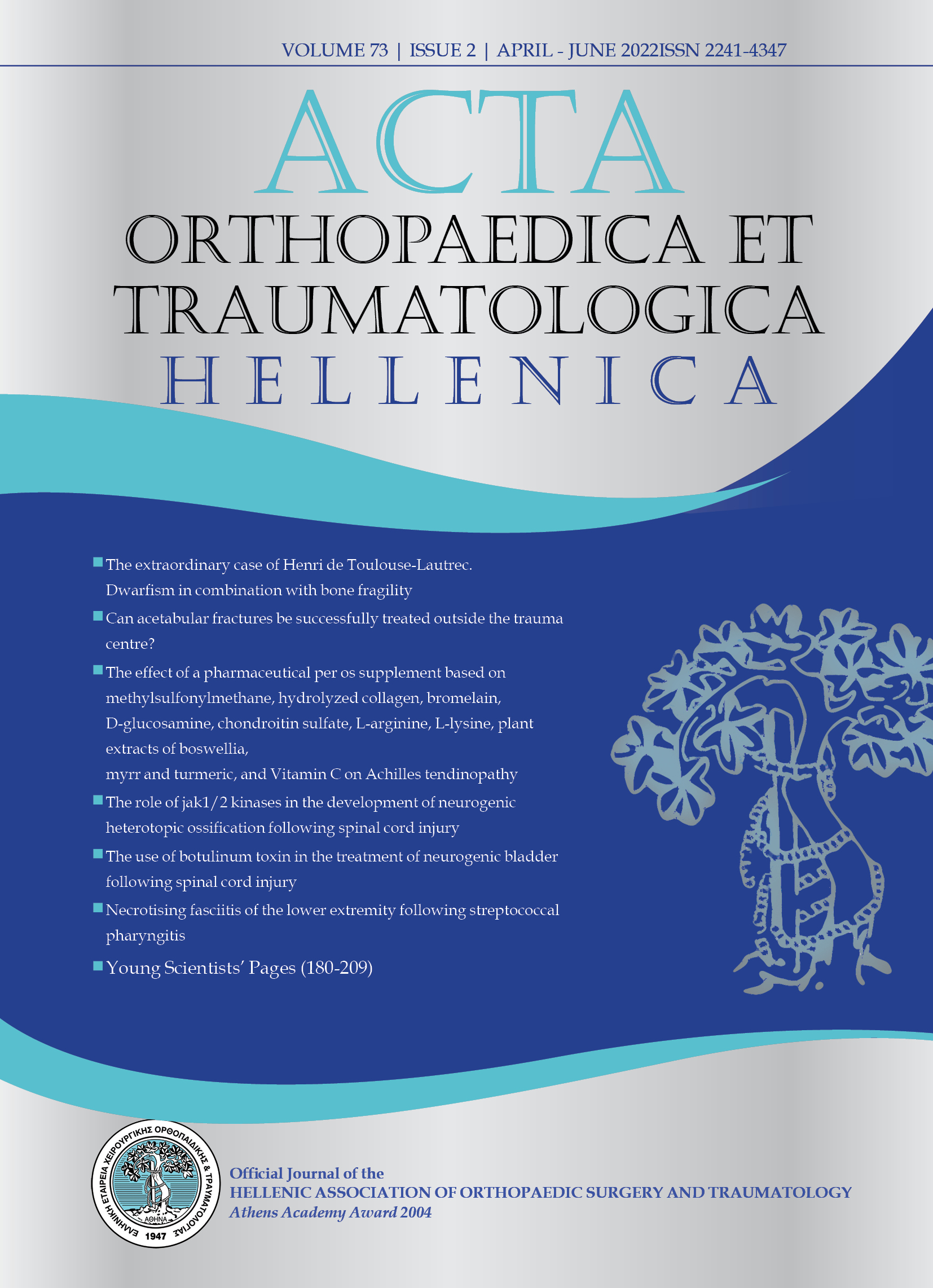The extraordinary case of Henri de Toulouse-Lautrec. Dwarfism in combination with bone fragility
Keywords:
Toulouse-Lautrec; dwarfism; bone fragility; osteogenesis imperfecta; osteopetrosis; pycnodysostosisAbstract
Henri de Toulouse-Lautrec, a descendant of an aristocratic family from France, lived many years before the application of the achievements of genetics. Suffering from an illness unknown at the time, he was forced from an early age to isolate him self and unfold his unparalleled talent freely, without restrictions. His association with people living on the margins of society, along with his choice to immortalize everyday scenes from their lives on the canvas, compose the enigmatic puzzle of his character. At the same time, his habits, sexual preferences, alcohol addiction, and his premature death from syphilis are the reasons to start an in-depth investigation. The purpose of this study is to elucidate the deeper causes that guided the outlets of his art, at the same time that his short stature, combined with the fragility of his bones, trigger a variety of hypotheses surrounding an underlying inherited disease. Osteogenesis imperfecta justifies certain symptoms. Osteopetrosis involves clinical signs that were absent in Lautrec’s case. Pycnodysostosis, however, seems to fulfill the requirements to be unequivocally accused. Our main pursuit, however, is not so much the revelation of the disease from which the artist suffered, as the understanding of his art and the delight given by the correct reading of his works.
Downloads
References
2. Castle WE. Mendel’s Law of Heredity. Proceedings of the American Academy of Arts and Sciences 1903; 38: 535-548.
3. Bowler PJ. The Mendelian revolution: The emergence of hereditarian concepts in modern science and society. Journal of the History of the Behavioral Sciences 1990; 26: 379-382.
4. El-Hani CN. Between the cross and the sword: The crisis of the gene concept. Genetics and molecular Biology 2007; 30: 297-307.
5. Collins FS, Barker AD. Mapping the cancer genome. Pinpointing the genes involved in cancer will help chart a new course across the complex landscape of human malignancies. Sci Am 2007; 296(3): 50-57.
6. Potter M. Brief historical sketch of chromosomal translocations and tumors. J Natl Cancer Inst Monogr 2008; 39: 2-7.
7. Kaiser J. Profile: Best Vogelstein. Cancer genetics with an edge. Science 2012; 337(6092): 282-284.
8. Frey Julia. Toulouse-Lautrec: A Life. London: Weidenfeld & Nicolson, 1994.
9. Ives Colta. Toulouse-Lautrec in the Metropolitan Museum of Art. New York: Metropolitan Museum of Art, 1996.
10. Thomson, Richard, Phillip Dennis Cate, and Mary Weaver Chapin. Toulouse-Lautrec and Montmartre. Exhibition catalogue. Washington, D.C.: National Gallery of Art in association with Princeton University Press, 2005.
11. Joan C. Marini. Osteogenesis Imperfecta. In Kliegman, Behrman, Jenson, Stanton’s (editors) Nelson Textbook of Pediatrics, 18th edition 2007; WB Saunders Company. pp. 2887-2890.
12. Antoniazzi F, Bertoldo F, Mottes M, et al. Growth hormone treatment in osteogenesis imperfecta with quantitative defect of type I collagen synthesis. J Pediatr 1996; 129: 432-439.
13. Glorieux FH, Rauch F, Plotkin H, et al. Type V osteogenesis imperfecta: A new form of brittle bone disease. J Bone Miner Res 2000; 15: 1650-1658.
14. Glorieux FH, Ward LM, Rauch F, et al. Osteogenesis imperfecta type VI: A form of brittle bone disease with a mineralization defect. J Bone Miner Res 2002; 17: 30-38.
15. Kuivaniemi H, Tromp G, Prockop DJ. Mutations in fibrillar collagens (types I, II, III, and XI), fibril-associated collagen (type IX), and network-forming collagen (type X) cause a spectrum of diseases of bone, cartilage and blood vessels. Hum Mutat 1997; 9: 300-315.
16. Marini JC. Should children with osteogenesis imperfecta be treated with bisphosphonates? Nat Clin Prac Endo & Metab 2006; 2: 14-15.
17. Marini JC, Gerber NL. Osteogenesis imperfecta: Rehabilitation and prospects for gene therapy. JAMA 1997; 277: 746-750.
18. Marini JC, Hopkins E, Glorieux FH, et al. Positive linear growth and bone responses to growth hormone treatment in children with types III and IV osteogenesis imperfecta. J Bone Miner Res 2003; 18: 237-243.
19. William A. Horton and Jacqueline T. Hecht. Disorders involving defective bone resorption. In Kliegman, Behrman, Jenson, Stanton’s (editors) Nelson Textbook of Pediatrics, 18th edition 2007; WB Saunders Company. pp. 2882-2883.
20. Gerritsen EJ, Vossen JM, Fasth A, et al. Bone marrow transplantation for autosomal recessive osteopetrosis: A report from the Working Party on Inborn Errors of the European Bone Marrow Transplantation Group. J Pediatr 1994; 125: 896-902.
21. Tolar J, Teitelbaum SL, Orchard PJ. Osteopetrosis, mechanisms of disease review. N Engl J Med 2004; 351: 2839-2849.
22. Gelb BD, Shi GP, Chapman HA, et al. Pycnodysostosis, a lysosomal disease caused by cathepsin K deficiency. Science 1996; 273: 1236-1238.
23. Wittrock, Wolfgang. Toulouse-Lautrec: The complete Prints. New York: Harper & Row, 1985.
Downloads
Published
Issue
Section
License
Copyright (c) 2022 Acta Orthopaedica Et Traumatologica Hellenica

This work is licensed under a Creative Commons Attribution-NonCommercial 4.0 International License.


